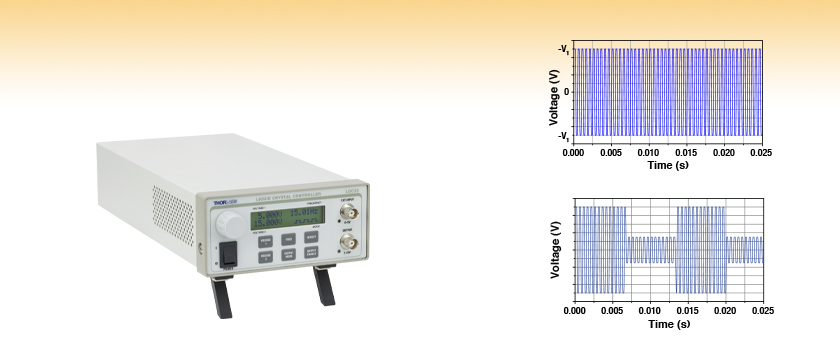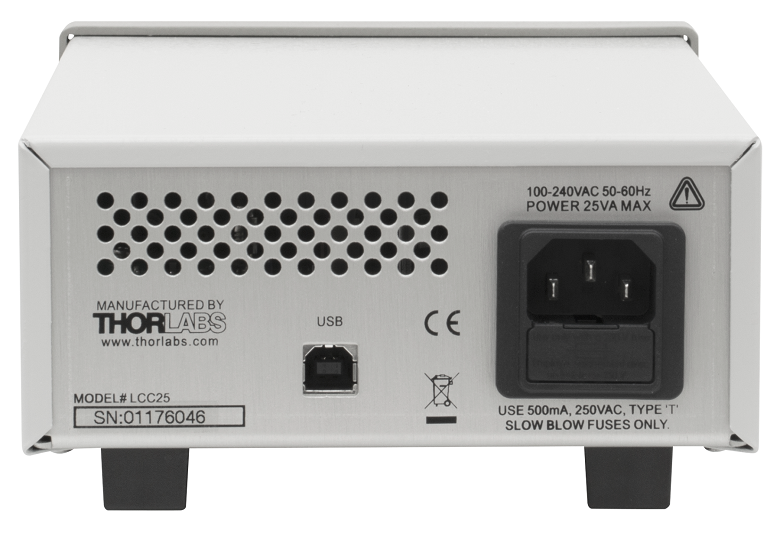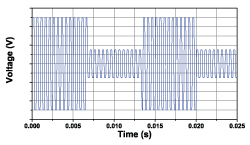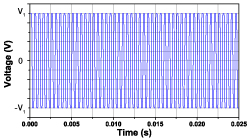Benchtop Voltage Controller for Liquid Crystal Devices

- Control LC Variable Retarders, Polarization Rotators, or Nematic LC Cells
- 0 to ±25 VAC, 2000 Hz Square Wave Output
- 0.5 to 500 Hz Modulation Between Two Voltage Settings
- BNC Output Connector
Constant Output Voltage
Modulated Output Voltage
LCC25
LC Voltage Controller

Please Wait

Click to Enlarge
Back Panel of the LCC25 Liquid Crystal Controller
Features
- Square-Wave Output Voltage
- Adjustable Amplitude: 0 to ±25 VAC
- Frequency: 2,000 ± 5 Hz
- Maximum Output Current: 15 mA
- Three User-Set Operating Modes: Voltage 1, Voltage 2, or Modulation
- Internally or Externally Controlled Modulation Between Two Output Voltage Amplitudes
- Internal: 0.5 to 150 Hz
- External (0 to 5 V TTL Signal): 0.5 to 500 Hz
- Control Using Device Front Panel or via USB Input from a PC
- Settings can be Saved to Allow Stand-Alone Operation via Front Panel Controls
- Dimensions: 146 mm x 78 mm x 309 mm
The LCC25 liquid crystal controller is compatible with many of our liquid crystal (LC) devices (see the table to the right). It produces a 2000 Hz square-wave AC voltage output with an amplitude that can be varied from 0 Vrms to ±25 Vrms. Nematic LC retarders must be driven with an AC voltage in order to prevent the separation and build up of charge, which can cause the device to burn out. In addition to the 2000 Hz AC drive voltage, the LCC25 controller automatically zeros the DC bias across the LC device to within 10 mV in order to counteract the buildup of charges.

Figure 2. A plot of the output voltage of the LCC25 Liquid Crystal Controller when the output voltage is being modulated between the two set voltages.

Figure 1. A plot of the output voltage of the LCC25 Liquid Crystal Controller when it is being operated in the constant voltage mode.
The AC output voltage amplitude can be set using the front panel controls, an external 0 - 5 VDC TTL input, or via the USB interface. Both the front panel and USB interface allow the user to select two voltage levels, Voltage 1 and Voltage 2. When the LCC25 is operated in the constant voltage mode, the output of the controller will be a 2000 Hz square wave with an amplitude equal to either of the two set voltage levels (Figure 1). Alternatively, in Modulation mode, the amplitude of the 2000 Hz square wave output will switch between Voltage 1 and Voltage 2 at a frequency that can be set internally (0.5 Hz to 150 Hz, see Figure 2) or triggered externally with 0 to 5 V TTL input (0.5 Hz to 500 Hz). The modulated mode can also be used to measure the response time of the LC retarder.
The USB interface can also be used to send line commands to the controller so that the LCC25 can be used in automated lab sequences. This enables operation through a terminal interface or control of the device using a written program.
Thorlabs also offers the KLC101 K-Cube™ Liquid Crystal Controller.
| LCC25 Physical Specifications | |
|---|---|
| External Input Connector | BNC |
| External Input Enable | Front Panel: INT/EXT enable Key |
| External Input Indicator | Green LED |
| Output Connector | BNC |
| Output Enable | Front Panel: OUTPUT ENABLE Key |
| Output Indicator | Green LED |
| Rotary Knob | Digital Encoder |
| Display | LCD 16 x 2 |
| Power Switch | Rocker Switch |
| USB interface | USB Standard B Plug |
| Dimensions | 5.75" x 3" x 12.2" 146 mm x 78 mm x 309 mm |
| Weight | 3.6 lbs |
| Operating Temperature Range | 10 to 40 °C |
| Maximum Relative Humidity | 85% |
| Other | Tilting Rubber-Padded Feet |
| LCC25 Electrical Specifications | |
|---|---|
| Adjustable Output Voltage | 0 to ±25 V RMS |
| External Input Voltage | 0 to 5 VDC Square Wave |
| Voltage Resolution | 1.0 mV |
| Adjustable Internal Modulation Frequency | 0.5 to 150 Hz at 50% Duty Cycle |
| Switching Frequency | 2,000 ± 5 Hz, 50% Duty Cycle |
| Slew Rate | 10 V/µs |
| DC offset | ±10 mV |
| Max Output Current | 15 mA |
| AC Power | 85 - 264 VAC, 47 - 63 Hz, 25 VA |
| Fuse Rating | 125 mA, 5 x 20 mm SLO-BLO |
| Warm Up Time | 30 Minutes |

Click to Enlarge
Screenshot of the GUI interface in Modulation Mode
Software for the LCC25 Controller
Graphical User Interface
The graphical user interface (GUI) included with the software provides access to all of the settings of the liquid crystal controller. For example, the user can select one of two user-defined voltages or a modulation mode that oscillates between these two voltages at a user-defined frequency. As shown in the screen shot to the right, the GUI includes a plot of the output voltage with respect to time. Both the output and external input can be turned on and off via the GUI. In addition, advanced features allow the user to define a custom waveform by specifying the starting voltage, ending voltage, the voltage step size, and the dwell time. The waveform may be previewed on the screen before it is output to the retarder, and it may be saved so that the LCC25 can be restarted quickly in the future. The GUI is available as a stand-alone or LabVIEW based version for flexibility in implementation.
Custom Software Development
Users may also use the provided C/C++ and LabVIEW software development kits for implementing the liquid crystal retarder controller with other instruments. Sample C++ code and LabVIEW programs help to illustrate how the C commands and LabVIEW VIs can be utilized. Full documentation on the available commands is provided with the software.
| Posted Comments: | |
Hadeel Alqasiri
(posted 2022-05-02 17:02:40.903) How can I download LCC25 drivers? cdolbashian
(posted 2022-05-10 04:04:00.0) Thank you for reaching out to us. The drivers for the LCC25 are included in the software download, found on the "Software" tab on this page above. |
 Products Home
Products Home





 LC Voltage Controller
LC Voltage Controller